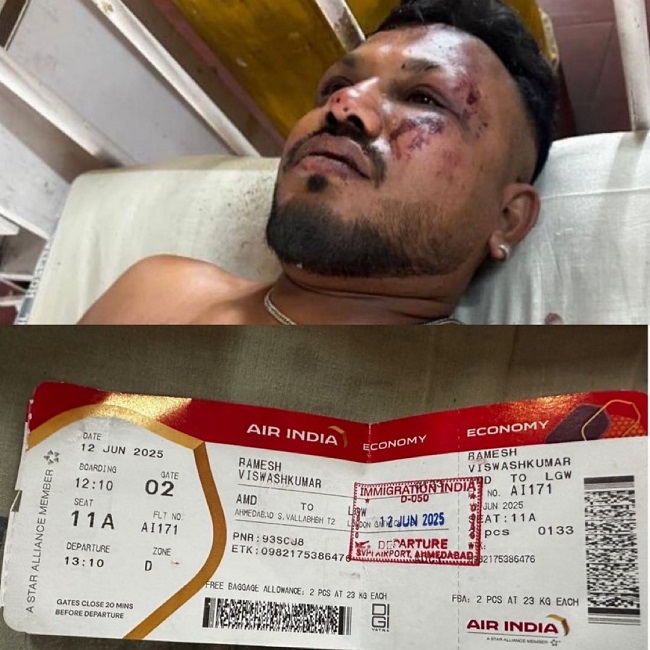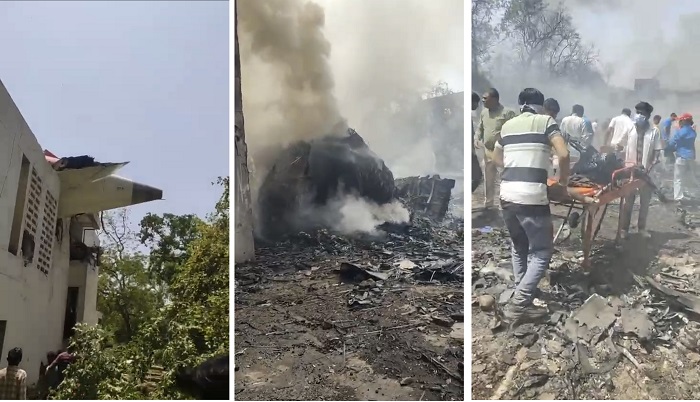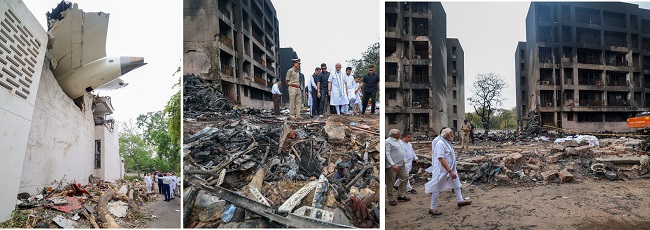A devastating aviation disaster unfolded in Ahmedabad yesterday, June 12, 2025, when Air India Flight AI-171, a Boeing 787-8 Dreamliner en route to London Gatwick, crashed moments after takeoff. The tragic incident, occurring at approximately 1:38 PM IST, resulted in the deaths of 269 individuals, marking the world’s worst aviation tragedy in a decade and the first-ever fatal crash involving a Boeing 787 Dreamliner.
The aircraft, carrying 230 passengers and 12 crew members, plummeted into a hostel block at B. J. Medical College in the Meghani Nagar area, a mere 30 seconds after departing from Sardar Vallabhbhai Patel International Airport. The timing, during the college’s lunch hour, amplified the horrific impact on the ground.
The Catastrophic Sequence of Events


CCTV footage captured the distressing final moments of Flight AI-171, showing the aircraft struggling to gain altitude, briefly hovering, and then crashing with a massive explosion. Reports indicate that the pilots issued a “Mayday” call immediately after takeoff, signaling a critical emergency, but subsequent attempts by air traffic control to establish communication were unsuccessful.
The enormous quantity of fuel on board, approximately 1.25 lakh liters (about 33,000 gallons), combined with Ahmedabad’s atmospheric temperature of nearly 40 degrees Celsius, and fueled an intensely hot explosion. This, coupled with the aircraft being at almost full capacity, significantly amplified the devastation, drastically reducing any chance of survival for those aboard.
Heavy Toll of Lives Lost


Of the 242 individuals aboard the flight, 241 perished. The sole survivor, identified as 40-year-old British-Indian passenger Vishwash Kumar Ramesh, was seated at an emergency exit, seat no 11 A, and managed to escape the wreckage with injuries. He is currently receiving treatment at a local hospital.
The diverse nationalities of those on board, including 169 Indians, 53 Britons, 7 Portuguese, and 1 Canadian, have drawn international condolences and concern.
On the ground, the impact of the crash was equally devastating. The aircraft directly struck a medical college men’s hostel block where over 100 students and their relatives were gathered for lunch, resulting in 51 confirmed fatalities and approximately 60 injuries among those on the ground. While initial casualty figures varied, current confirmed counts indicate 241 deaths on board and 531 confirmed ground fatalities, contributing to a total of 294 confirmed deaths. Among those tragically lost was former Gujarat Chief Minister Vijay Rupani.
The situation for those injured on the ground remains critical. Several local residents admitted to the Civil Hospital in Ahmedabad are in very serious condition, with five critically ill and twelve others seriously injured still undergoing treatment. Furthermore, police official sources report that over 50 local people are currently missing, leading authorities to fear the total death toll could tragically exceed 300. Should this grim projection materialize, it would mark the second-biggest airplane accident in India’s aviation history.
Emergency Response and Ongoing Investigation


Emergency teams, including the National Disaster Response Force (NDRF), Indian Air Force (IAF), Border Security Force (BSF), and National Security Guard (NSG), swiftly launched extensive rescue, recovery, and DNA identification efforts.
India’s Aircraft Accident Investigation Bureau (AAIB) has taken the lead in the probe, with vital support from the US National Transportation Safety Board (NTSB) and the UK Air Accidents Investigation Branch (AAIB). Boeing has also pledged its full cooperation. Both the cockpit voice recorder and flight data recorder have been recovered and are crucial to understanding the cause of the disaster. Authorities are meticulously analyzing whether a technical malfunction or other factors led to the aircraft stalling and descending so rapidly after takeoff.
National Mourning and International Condolences


Prime Minister Narendra Modi expressed profound sorrow, describing the tragedy as “heartbreaking beyond words.” He visited the crash site and hospital to meet with survivors and offer condolences to the grieving families. Union Home Minister Amit Shah, after visiting the sole survivor, reiterated the grim reality that the immense fuel load and high temperatures prevented any further rescues.
Messages of support and condolences have poured in from nations around the world, including Britain, Canada, and Portugal, underscoring the global impact of this tragedy.
A Stark Reminder for Aviation Safety
This catastrophic incident stands as one of India’s worst single-aircraft air disasters in decades, surpassed only by the 1996 mid-air collision near Charkhi Dadri. The tragedy has sent shockwaves through families, triggered urgent reviews of Boeing 787 safety protocols, and intensified scrutiny on aircraft operations and maintenance standards globally.
As investigators continue their arduous work to determine the definitive causes of this crash, the focus remains on preventing such devastating losses in the future and providing support to those whose lives have been irrevocably altered.
